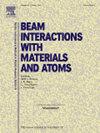Application of 7Li(p, α)4He NRA for thin film type all-solid-state Li battery; reinvestigation of 7Li(p, α)4He cross-section and optimization of experimental arrangement
IF 1.4
3区 物理与天体物理
Q3 INSTRUMENTS & INSTRUMENTATION
Nuclear Instruments & Methods in Physics Research Section B-beam Interactions With Materials and Atoms
Pub Date : 2025-07-11
DOI:10.1016/j.nimb.2025.165787
引用次数: 0
Abstract
The 7Li(p, α)4He reaction is used to observe the Li behavior during the discharge and recharge process in the thin-film-type all-solid-state Li battery. The incident proton beam energy used in this nuclear reaction analysis (NRA) was set at 1.5 MeV. The emitted α-particle in NRA and backscattered proton in Rutherford backscattering spectrometry (RBS) were detected by the same silicon surface detector (SSD) simultaneously. First of all, the cross sections of 7Li(p, α)4He for the proton energies between 1.0 and 1.5 MeV were experimentally determined in order to make quantitative analyses. Next, the emission angle of the α-particle with respect to the surface normal was explored to determine the optimum angle to distinguish the layers in the battery sample. By using the obtained cross-sections and optimized emission angle, the 7Li NRA profiles on the battery sample at the charged state and discharged state were taken. The Li migration in the battery due to these processes was clearly observed. The results implied that whole the electrolyte seemed to play the role of both the electrolyte and the anode.
7Li(p, α)4He NRA在薄膜型全固态锂电池中的应用7Li(p, α)4He截面的重新研究和实验布置的优化
采用7Li(p, α)4He反应观察了薄膜型全固态锂电池充放电过程中的锂离子行为。核反应分析(NRA)中使用的入射质子束能量设定为1.5 MeV。用同一硅表面探测器(SSD)同时检测NRA中发射的α-粒子和卢瑟福后向散射光谱(RBS)中的后向散射质子。首先,对质子能量在1.0 ~ 1.5 MeV之间的7Li(p, α)4He的截面进行了实验测定,并进行了定量分析。其次,研究α-粒子相对于表面法线的发射角,以确定区分电池样品层的最佳角度。利用得到的截面和优化后的发射角,对电池样品在充电状态和放电状态下的7Li NRA曲线进行了测量。这些过程引起的锂离子在电池中的迁移被清楚地观察到。结果表明,整个电解液似乎同时起到电解液和阳极的作用。
本文章由计算机程序翻译,如有差异,请以英文原文为准。
求助全文
约1分钟内获得全文
求助全文
来源期刊
CiteScore
2.80
自引率
7.70%
发文量
231
审稿时长
1.9 months
期刊介绍:
Section B of Nuclear Instruments and Methods in Physics Research covers all aspects of the interaction of energetic beams with atoms, molecules and aggregate forms of matter. This includes ion beam analysis and ion beam modification of materials as well as basic data of importance for these studies. Topics of general interest include: atomic collisions in solids, particle channelling, all aspects of collision cascades, the modification of materials by energetic beams, ion implantation, irradiation - induced changes in materials, the physics and chemistry of beam interactions and the analysis of materials by all forms of energetic radiation. Modification by ion, laser and electron beams for the study of electronic materials, metals, ceramics, insulators, polymers and other important and new materials systems are included. Related studies, such as the application of ion beam analysis to biological, archaeological and geological samples as well as applications to solve problems in planetary science are also welcome. Energetic beams of interest include atomic and molecular ions, neutrons, positrons and muons, plasmas directed at surfaces, electron and photon beams, including laser treated surfaces and studies of solids by photon radiation from rotating anodes, synchrotrons, etc. In addition, the interaction between various forms of radiation and radiation-induced deposition processes are relevant.

 求助内容:
求助内容: 应助结果提醒方式:
应助结果提醒方式:


